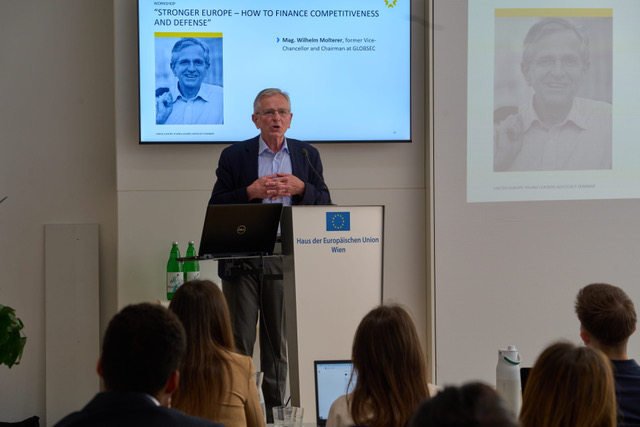“Read the Draghi report, I have never seen such a perfect script for the future of Europe” said Wilhelm Molterer, former Austrian Vice Chancellor and Chairman at GLOBSEC at our recent Young Leaders Advocacy Seminar in Vienna. He continued: “Franz Joseph Strauss launched Airbus in the 60s. It was the only European initiative of substance. This shows how big and dramatic our gaps are!”
 To make Europe stronger, we must advance along four dimensions: Economic strength, military capability, global ambition (e.g., enlargement), and internal stability (rule of law, democracy). These are interconnected and require coordinated strategy and financing. The Draghi Report lays out a powerful, multidimensional blueprint for the continent’s economic future. Its central message is clear: sustainability and competitiveness are inseparable, provided we understand sustainability not as constraint, but as transformation.
To make Europe stronger, we must advance along four dimensions: Economic strength, military capability, global ambition (e.g., enlargement), and internal stability (rule of law, democracy). These are interconnected and require coordinated strategy and financing. The Draghi Report lays out a powerful, multidimensional blueprint for the continent’s economic future. Its central message is clear: sustainability and competitiveness are inseparable, provided we understand sustainability not as constraint, but as transformation.
A four pillar approach to European Competitiveness:
-
- Economic security: Achieved through open strategic autonomy—or better yet, strategic responsibility—to reduce critical dependencies while staying open and engaged.
- Global competition: Europe must close its investment gap compared to the U.S. and China, which continue to outpace the EU in critical areas such as AI, tech, and defense.
- Market integration: Fragmentation in planning, investment, and regulation weakens Europe’s internal market. True competitiveness requires completing the Capital Markets Union, advancing energy and digital integration, and building a genuine telecoms single market.
- Resilience: Europe must strengthen its capacity to adapt to shocks—whether military, economic, or environmental—by building cohesive, long-term investment strategies.
Closing the Capital and Investment Gaps: Europe needs 750-800 billion annually to close investment gaps in the years to come. The absence of a true Capital Markets Union and fragmented energy as well as a non-existing European telecommunication single market, are major bottlenecks. The single market is the single biggest driver of economic development, but its current state of fragmentation undermines its potential. Letta’s proposal includes:
-
-
- A “5th freedom” focused on free movement of research, innovation and knowledge
- Advancing a European infrastructure strategy, especially in rail, to connect member states and improve mobility. This alone requires €500 billion
-
Defense: The Economic and Strategic Imperative: Europe’s security reality has changed. Defense spending needs to increase significantly (€650 billion over four years).Von der Leyen proposes loosening the Maastricht criteria for defense investments and expanding EU-level financing mechanisms. The Ministers’ Report stresses:
-
-
-
- A shared willingness to defend, as exemplified by Finland, Sweden
- Deep Coordination within the EU and with NATO
- Public-private partnership (PPP) in defense, supported by initiatives like SAFE (€150 billion) offering blueprints for mobilizing both public and private resources
-
-
Overcoming Budget Constraints: A New European Financing Strategy: National budgets are constrained, and excessive reliance on them has only deepened fragmentation. Member states continue to act based on national brokerage, not European strategy. The current EU budget (just €200 billion), with only €2.6 billion for defense and €21 billion for innovation – is not fit for purpose. Solutions include:
national brokerage, not European strategy. The current EU budget (just €200 billion), with only €2.6 billion for defense and €21 billion for innovation – is not fit for purpose. Solutions include:
-
-
- Redirect spending from agriculture or cohesion policy (a politically explosive move)
- Scale up EU-level financing tools, like Recovery and Resilience Facility (RRF) and Eurobonds, which have proven credible and well-received by markets
- Shift to project-based financing at the European level, similar to the US model, where capital markets complement bank lending and helped speed up post-crisis recovery.
-
Mobilising Europe’s Private Wealth: Europe is not short on capital. With a 15% savings rate and nearly €30 trillion under institutional management, the challenge is not money – it’s mobilisation. outside the EU in Switzerland and the UK then Germany, France and the Netherlands. Investor cite lack of financeable projects and complex regulation. A combined Capital and Investment Union could unlock:
-
-
-
- Unlocking retail and institutional equity investment
- Facilitating cross-border capital flows
- Keeping European money invested in European priorities (Investors see a lack of bankable and financeable projects and regulation is difficult).
-
-
Empowering European Institutions: Institution like the European Investment Bank (EIB) remain underleveraged. With AAA credit and ownership by EU member states, the EIB can mobilise billions in private investment, especially when backed by EU member states, the EIB can mobilise billions in private investment, especially when backed by budgetary guarantees. Financial instruments tied to such guarantees have already yielded impressive returns: from €33 billion in guarantees, the EU has mobilised €100 billion in financial instruments, leading to over €500 billion in investment and €400 billion in private capital.
Complementing this, national promotional banks in countries like Germany, Poland, and Hungary must be better integrated into a European investment strategy. And simple steps – like removing internal trade barriers – could improve efficiency at zero budgetary cost.
CONCLUSION
Europe can no longer afford to muddle through. The past 70 years brought peace and prosperity, but also bred a dangerous naivety. The world is no longer waiting for Europe to lead.
Q&A
 What is your perspective on introducing tax holidays periods or VAT exemptions for critical infrastructure industry and the defense industry?
What is your perspective on introducing tax holidays periods or VAT exemptions for critical infrastructure industry and the defense industry?
The key question is to what extent the European Union should relax its fiscal rules. In my view, the better path is to relax the Maastricht criteria, particularly by introducing targeted exemptions – such as for defense spending. This approach is preferable to relaxing tax rules, which could lead to a downward spiral with no clear end.
Once you begin adjusting tax regimes, you risk triggering competitive distortions between member states – especially problematic given the EU’s ongoing efforts to ensure fairness in areas like corporate tax.
Value added Tax (VAT), in particular, must remain aligned with the logic of the Single Market. Diverging consumption-based taxes undermine market integration. That’s why maintaining a coherent, Single Market-oriented tax regime is essential. For me, the priority is clear: focus on flexible fiscal rule where needed, but keep the tax framework harmonized.
You mentioned Airbus as a successful European industrial initiative. Given Europe’s traditionally strong antitrust and anti-monopoly regulations, is it time to reconsider this approach? Should the EU allow for the creation of more “European champions” -even if that means tolerating market dominance at home – in order to secure globally competitive monopolies in strategic sectors?
Defense is inevitably pushing us in this direction – especially after the brutal wake-up call from Trump. We can no longer afford to wait in the face of potential emergencies. Article 42 of the EU treaties has never been tested in real crisis, and we lack practical experience in collective response. Nevertheless, we must learn to stand on our own two feet.
The only instance Article 42 was invoked was after the Charlie Hebdo attack – highlighting just how underdeveloped our mutual defense mechanisms are.
All efforts to build a European defense capability must be rooted in joint investment, joint procurement, and full interoperability.
One idea currently being discussed – though informally – is that relying on all 27 member states is unrealistic unless there is true alignment. Therefore, leadership must come from the “Big Five”: Germany, France, Italy, Spain, and Poland. These countries must drive the process forward. A clear European prioritization in defense is essential – period. Defense will not just be a matter of security; it will become a key driver of economic transformation.
Much of Europe’s current weakness stems from fragmentation – and the solution often lies in deeper integration. Do you see a federalized Europe as a realistic and necessary step forward? Could this be our historic challenge: to build a more unified Europe capable of shaping a tripolar world – alongside the US and China- where Europe finally stands on its own two feet?
The European Commission has been weakened, while the European Council has gained power – a conceptual mistake. It’s as if we are weakening the central government while strengthening the governors.
I envision a multi-layered European Union. An old idea – the European Economic Area – could offer a pragmatic first step for countries like Ukraine and the Western Balkans. This structure allows for gradual integration without diluting the core of the union.
Take Denmark, for example. It is now seriously considering adopting the euro in the long term. That reflects a broader truth: we may have one goal, but different speeds in reaching it. Schengen should be for everyone, but not necessarily at the same time. What matters is the shared destination: one European Union, not two parallel versions. A dual-track Europe would ultimately undermine the Union’s cohesion and credibility.
Political thinker Herfried Münkler has spoken about a multipolar world with five centers of power. But we must ask: are we heading for a truly multipolar world, or merely a bipolar one dominated by the US and China?
And critically: Are we listening to what Africa is saying? Many African nations now find themselves caught between Russia and China. Meanwhile, Europe is not even invited to the table- whether by Washington, Bejing, Moscow, or others. This should be a wake-up call.
The world is moving ahead – on trade, geopolitics, GDP, production, and especially demographics. Consider this: Nigeria is projected to become the third most populous country. What kind of relationship are we building with Nigeria?
Ultimately, it is up to us. Europe’s future standing in the world depends on the choices we make now. For too long, we may have been naïve, coasting on the assumptions of the past 70 years. That time is over.
European competition policy has often blocked major mergers – like Siemens and Alstom, in rail, or consolidation in telecoms – despite increasing global competition.
At the same time, the Letta report argues for allowing more large-scale European mergers to build globally competitive champions. For instance, a company like Deutsche Telekom could easily acquire smaller operators in countries like Estonia. How do we strike the balance between safeguarding competition within EU borders and building the scale needed to compete with China and the US?
This is the heart off the issue. If Europe wants to be a global player, we must find a balance between internal market competition and external industrial strength. Airbus is a prime example: It’s a global competitor without harming consumer access or market diversity in smaller EU countries. It proves that common rules and strong market oversight can coexist with ambitious industrial policy.
Take telecoms: Europe has 29 national telecoms companies, while the US operates with just five major players. The result? Fragmentation – and European consumers and businesses ultimately pay the price. Are we prepared to continue paying the price for the sake of maintaining the status quo.
On competition policy, in recent years the Commission has ruled against projects such as Airbus and big mergers. For example, Siemens, Alstom, transport industry and telecoms. Now the Letta report says we need more big mergers. Deutsche Telekom could just buy up Estonia’s telecom operators. How to balance intra competition within EU border and global competition with China and the US?
This is always the question. If you want to be a global player you will have to strike a balance between national and global competition. Airbus is a wonderful example for global competition and it has no impact on any flight connection to Estonia. You can put into place rules for everybody. It is more about keeping the market functioning than keeping with industrial policy. We have 29 telecom companies in Europe and in the US, we have 5. We pay for that. Are we ready to pay for that in the long run?
The impulse was conducted as part of the Young Leaders Seminar on April 30, 2025, in Vienna. You can view the full seminar here. We thank Wilhelm Molterer for his participation.



